MARIANI’SVirtual
Gourmet
December 9,
2012
NEWSLETTER
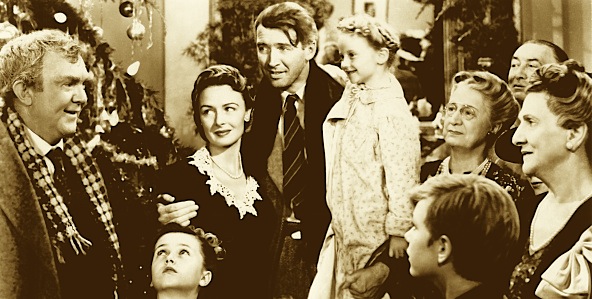
Thomas
Mitchell, Donna Reed, James Stewart, and Carolyn
Grimes in "It's a Wonderful Life" (1947)
THIS WEEK
L.A. Eats, Part One
by John Mariani
NEW
YORK CORNER
Ai Fiori
by
John Mariani
Pioneer Napa Valley Wine Maker Is Back
by Mort Hochstein
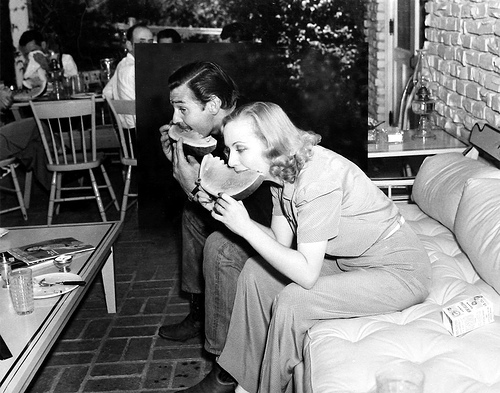
Clark Gable and Carole Lombard (1941)
Part One
by John Mariani
The down period for Los Angeles dining, which began about the time one-state-over Las Vegas began to steal its thunder, ended a couple of years ago, and now, with a slew of new restaurants typifying the city's diversity, it's time to re-consider L.A.'s ranking among American food towns.
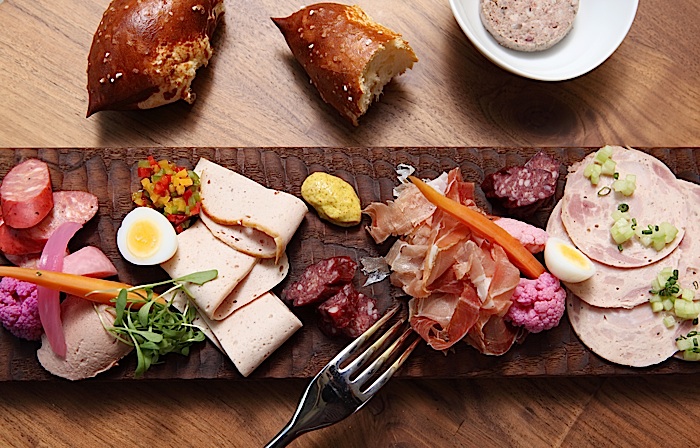 BierBeisl
BierBeisl
9669
South Santa Monica Boulevard
310-271-7274
Now, isn’t this just what
Beverly Hills—where people would sell their bodies
for the “A” tables at Spago, Cut and Mr. Chow—were
dying
for? A
humble little Austrian restaurant with a
six-foot-seven chef and nothing close to an “A”
table.
If
BierBeisl was only a place to get a platter of
wursts and some rare Austrian brews, it would be
welcome enough anywhere in L.A. But
when you get such great bursts of flavor from a
Käsekrainer sausage pumped up with oozy
Emmenthaler cheese and sharp pepper, and when an
appetizer of glazed white asparagus are as sweet
as candy and sprinkled with unexpected
sautéed sweetbreads, heirloom tomatoes,
lemon confit and veal jus, you
soon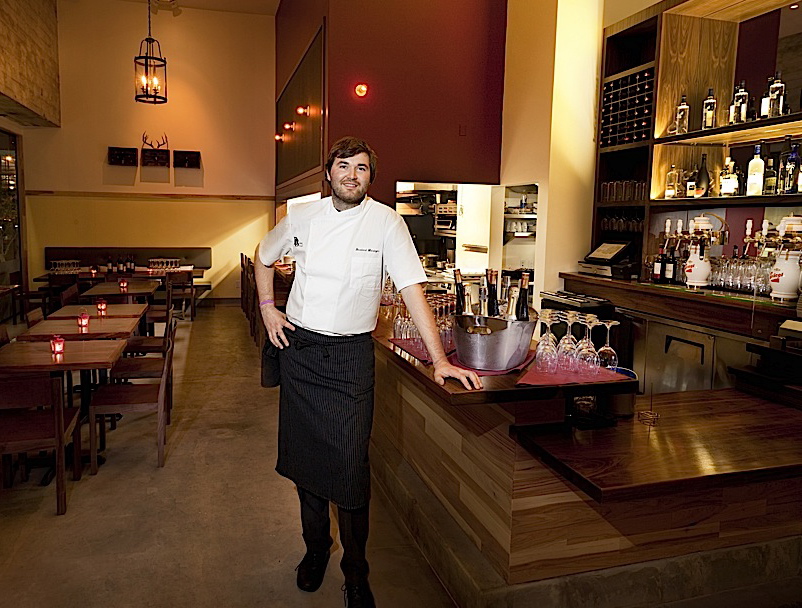 sense
that chef-owner Bernhard Mairinger is doing at
BarBeisl something far more special. Break
off the arm of a fat, soft pretzel and sop up the
vinaigrette on the carpaccio of silky pork roast.
At the end, rouse yourself to share that giddy
Austrian dessert called Kaiserschmarm
of golden, hot
meringue and warm plum compote. And, if you are
taller than Mairinger, you eat free!
sense
that chef-owner Bernhard Mairinger is doing at
BarBeisl something far more special. Break
off the arm of a fat, soft pretzel and sop up the
vinaigrette on the carpaccio of silky pork roast.
At the end, rouse yourself to share that giddy
Austrian dessert called Kaiserschmarm
of golden, hot
meringue and warm plum compote. And, if you are
taller than Mairinger, you eat free!
By all means ask Mairinger to pair up some
beers with his food. I did. Here’s what he said:
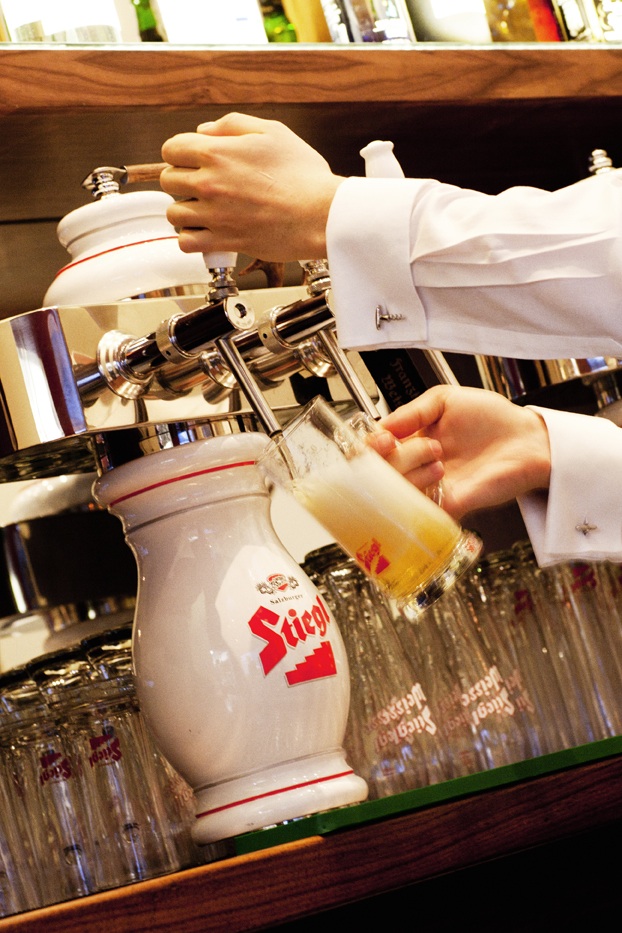 “For instance,
Weisswurst made with veal only and poached in milk
with onions is one the leanest, creamiest
sausages, so it is best with a creamy, hoppy
almost buttery sweet Stiegl Weisse, which is a
traditional, very popular combination in Bavaria.
“For instance,
Weisswurst made with veal only and poached in milk
with onions is one the leanest, creamiest
sausages, so it is best with a creamy, hoppy
almost buttery sweet Stiegl Weisse, which is a
traditional, very popular combination in Bavaria.
“Debreziner,
made with beef and pork, fresh horseradish and
tarragon mustard, is juicy, peppery, and spicy
with cayenne pepper, paprika, and caraway. I like
it with the Staropramen, my favorite Czech beer,
which adds bitterness and hoppiness, so the
slightly sweet flavor of fresh horseradish stays
on the palate along with the spices after every
bite, and even after the meal.
“Käsekrainer--Viennese
street food--is a peppery beef and pork sausage
that has Emmenthal cheese folded into the coarse
brat, so it literally explodes in your mouth, and
if you are not careful enough, all over your
shirt. Pair it with Anderson Valley Boont Amber
Ale, which is grassy, gently bitter, perfectly
balanced with a hint of hops and caramel.
“Bier Cabanossi is a coarse beef and pork steamed and smoked sausage served with pickles, tarragon mustard and peppercress, very good to eat with a dark Koestrizer Schwarzbier that has an almost coffee bitterness that supports the sweet-saltiness of the sausage and pickles.”
Bäco Mercat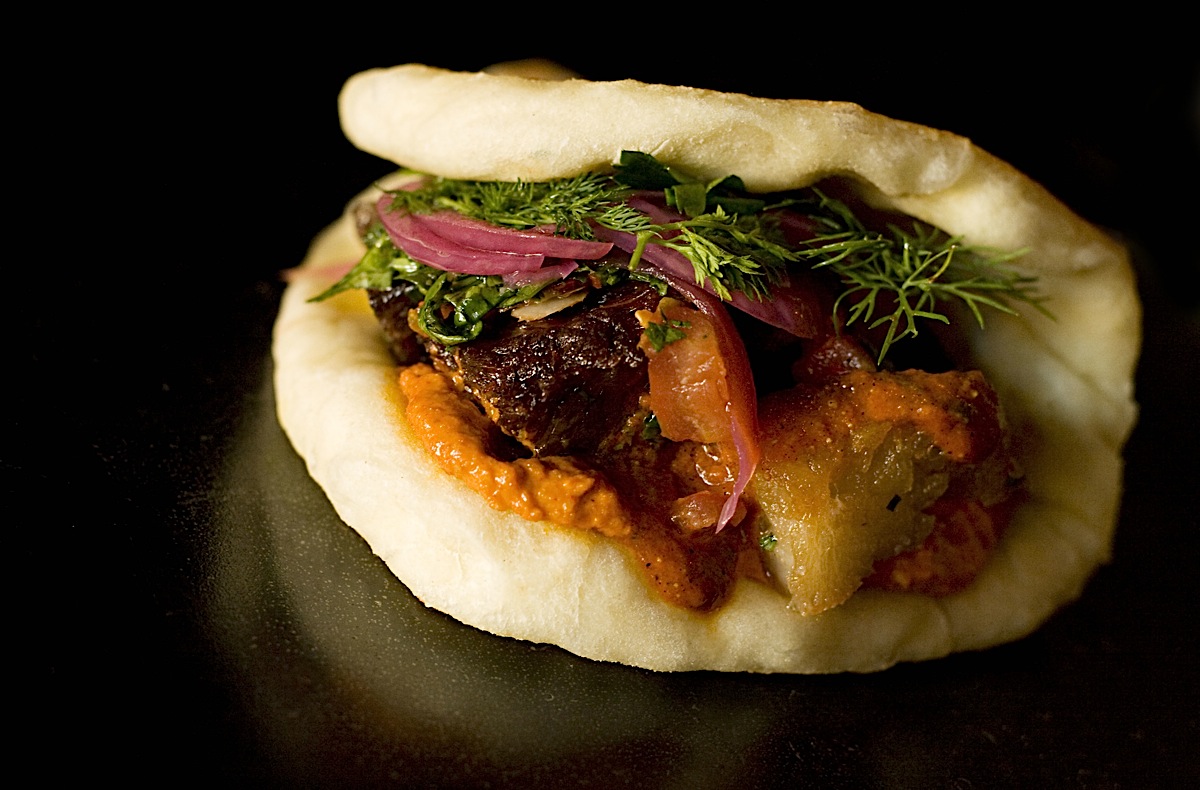
408 South Main Street
213-687-8808
It’s not about the
sandwich. Which is one helluva great sandwich:
a bäco (right)
is a freshly baked roll, somewhat like a soft taco
or pita, that in its original conception was
filled up from whatever was around the
kitchen—now, fried pork belly, carnitas, pickles,
and a sauce of tomato and almonds called salbitxada.
Variations followed fast—bäcos with crispy
shrimp, sriracha
hot sauce, and chive; oxtail hash, smoked Gouda
and mustard; beef tongue schnitzel with harissa,
smoked aïoli and pickle.
So 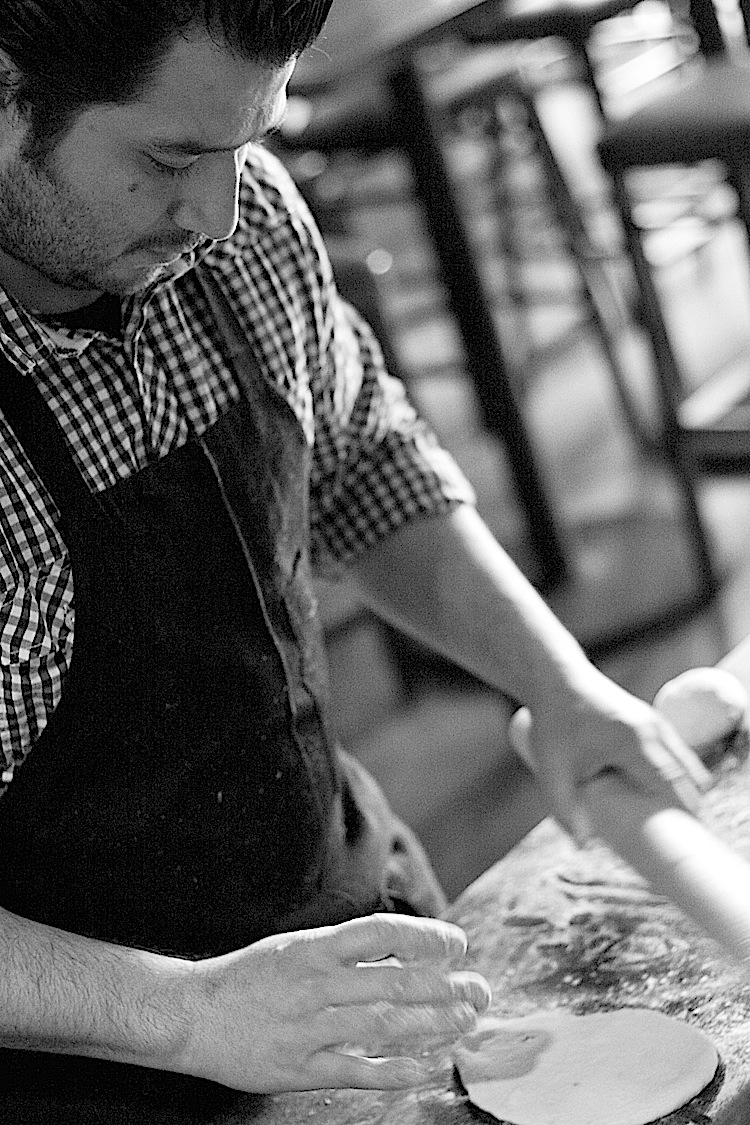 far so good, but chef-owner Josef
Centano (left),
last at the Lazy Ox, has also crafted a menu of
singular dishes that would garner raves at far
more deluxe dining rooms, deeply satisfying food,
crispy, crunchy, tender, spicy, each item
different and novel, like Centano’s chile relleno
with a pork ragù,
ricotta, and Monterey jack cheese, and his
blistered okra with tomato, mint and basil. His
flatbreads would be irresistible even without
wonderful toppings like romesco, anchovy and
lemon.
far so good, but chef-owner Josef
Centano (left),
last at the Lazy Ox, has also crafted a menu of
singular dishes that would garner raves at far
more deluxe dining rooms, deeply satisfying food,
crispy, crunchy, tender, spicy, each item
different and novel, like Centano’s chile relleno
with a pork ragù,
ricotta, and Monterey jack cheese, and his
blistered okra with tomato, mint and basil. His
flatbreads would be irresistible even without
wonderful toppings like romesco, anchovy and
lemon.
Bäco Mercat is not a place that says anything
glib about casual dining trends. It’s a place
entirely its own, unreproducible without
Josef Centano. “I wanted
a neighborhood place,” he says, “and it’s downtown
because that’s my neighborhood. I live across the
street. I love the Old Bank District and the
buildings here because of their history and
character and architectural bones. I didn’t have
the budget for a designer, so it’s a pretty DIY
place. I stripped and shined all the old brass in
the restaurant. I helped paint. A friend
recommended a craftsman who works with iron, and
he built the bar and the restaurant signs. It is
what it is.”
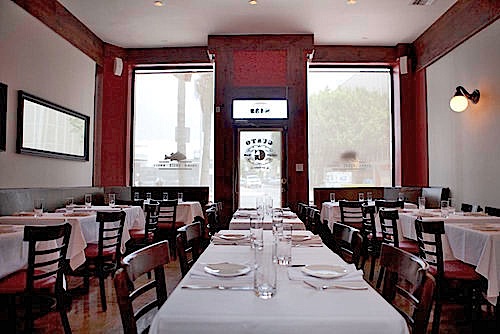 Gusto
Gusto
8432 W. Third Street
323-
782-1778
gusto-la.com
Victor Casenova has
fallen upwards. Two years ago, the very posh ristorante
moderna Culina at the Four Seasons Beverly
Hills, where he was a celebrated star chef, made Esquire’s
list. Now at his own little trattoria on the very
un-posh West Third Street, Bronx-born Casenova,
35, has gone back to his roots, with authoritative
renderings of Neapolitan pork braciole with wine
dark ragù
and bitter Swiss chard. He stuffs sweet peas,
ricotta, and mint into sheer ravioli dressed with
nothing more than lemon butter, and he spreads his
excellent, smoky pizzas with fresh funghi
porcini, a rich besciamella
cream, soft-centered burrata cheese,
smoky
pancetta bacon and a dash of thyme.
The room is small, three cozy rows of nicely-set tables, the colors are olive and red, the floor polished, the walls hung with Italian food posters, and white flowers flourish in a big terracotta vase. You are greeted by a manager named Molly, who is as pretty as she is affable, and Casenova will be in and out of the kitchen all night to ask how you like everything. You won’t have trouble telling him, except perhaps to stutter, trying to come up with enough superlatives.
1 PICO
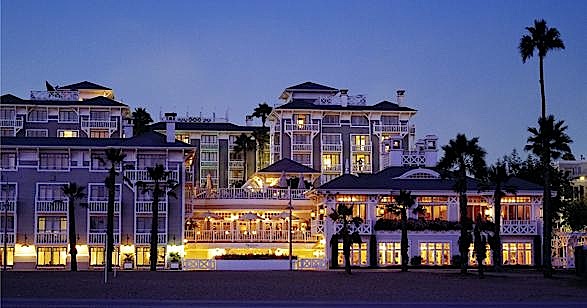
SHUTTERS ON THE BEACH
One Pico Boulevard
Santa Monica, CA
310-458-0030
www.shuttersonthebeach.com
Los Angeles
has plenty of first-rate deluxe hotels that mimic the
grand luxury style of Europe, including The Four
Seasons in Beverly Hills and The Bel-Air, but
for a unique flavor of breezy, seaside L.A. style is
Shutters on the Beach in Santa Monica is where I love
to stay, feeling like Randy Newman singing, "Roll down
the window/Put down the top /Crank up the Beach Boys,
baby/Don't let the music stop/We're gonna ride it till
we just can't ride it no more."
 The
architecture is Southern Cal, white clapboard,
terraces, rooms done in sandy and blue colors, with a
big welcoming lobby lounge great for cocktails. The
Santa Monica Pier is just a stroll away, the venerable
Chez Jay dive bar is down the street, and the area is
home to some of L.A.'s best restaurants, like
Michael's, Valentino, and Border Grill. Shutters
also has one the loveliest, chic restaurants in town,
called 1 Pico, where I've happily had occasion to have
excellent lunches over the past several years, as I
did on a brilliantly sunny day recently, in full view
of the Pacific. There is also a casual
booth-and-counter spot downstairs that puts out an
excellent and very friendly breakfast.
The
architecture is Southern Cal, white clapboard,
terraces, rooms done in sandy and blue colors, with a
big welcoming lobby lounge great for cocktails. The
Santa Monica Pier is just a stroll away, the venerable
Chez Jay dive bar is down the street, and the area is
home to some of L.A.'s best restaurants, like
Michael's, Valentino, and Border Grill. Shutters
also has one the loveliest, chic restaurants in town,
called 1 Pico, where I've happily had occasion to have
excellent lunches over the past several years, as I
did on a brilliantly sunny day recently, in full view
of the Pacific. There is also a casual
booth-and-counter spot downstairs that puts out an
excellent and very friendly breakfast.
Chef Anthony Zappola knows his
clientele wants to eat on the light side at lunch, and
sommelier Peter Neptune is always there to help with a
summery wine, no matter what the date in the calendar,
with plenty of wines by the glass of carafe and a
remarkable number of bottles under $50, with an
even-handed stock of California's best and fine wines
from the rest of the world.
On my last
visit I began with creamy burrata cheese coupled with English
peas and walnuts, and it was tough 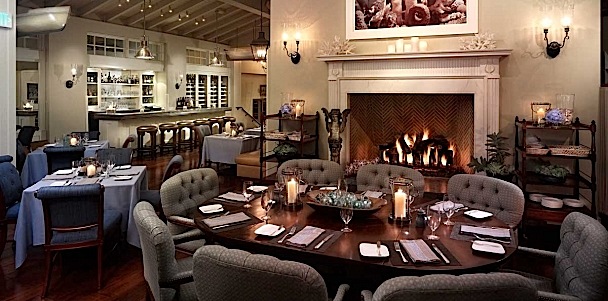 not gorging on the terrific
goat's cheese flatbread with grapes, arugula, and a
dash of basil pesto. This being California, there is a
Caesar salad, with grilled chicken. There are also
four sandwiches, and I always order the lobster club
item, which really holds a lot of lobster atop
toasted, buttered brioche, with smoked bacon and, to
give it a Southern Cal touch, ripe avocado.
There's also a grilled shrimp Cobb salad, generously
proportioned. Typical of the sunny pastas here, there
is a saffron-scented well-wrought risotto with
mushrooms, and one of the signature items at 1 Pico is
the Jidori chicken with fingerling potatoes, green
olive, and pine nuts.
not gorging on the terrific
goat's cheese flatbread with grapes, arugula, and a
dash of basil pesto. This being California, there is a
Caesar salad, with grilled chicken. There are also
four sandwiches, and I always order the lobster club
item, which really holds a lot of lobster atop
toasted, buttered brioche, with smoked bacon and, to
give it a Southern Cal touch, ripe avocado.
There's also a grilled shrimp Cobb salad, generously
proportioned. Typical of the sunny pastas here, there
is a saffron-scented well-wrought risotto with
mushrooms, and one of the signature items at 1 Pico is
the Jidori chicken with fingerling potatoes, green
olive, and pine nuts.
It's the easiest thing in
the world to sit at 1 Pico, have an extra glass of
California chardonnay, look out at the ocean then
contemplate either a stroll on the beach or a nap.
Whatever you opt for, tomorrow is tomorrow and you do
one or the other after a fine lunch.
1
Pico is open for lunch Mon.-Sat, dinner nightly,
Sun. brunch; Lunch special $29 for two courses;
Dinner appetizers $12-$19; main courses $25-$33.
There will be Christmas Eve Christmas Day, and
Reveillon menus.
❖❖❖
NEW
YORK CORNER
by
John Mariani
Ai Fiori
Setai Hotel
500 Fifth Avenue (near 36th Street)
212-613-8660
www.aifiorinyc.com
Photos by Evan Sung and Ted Axelrod
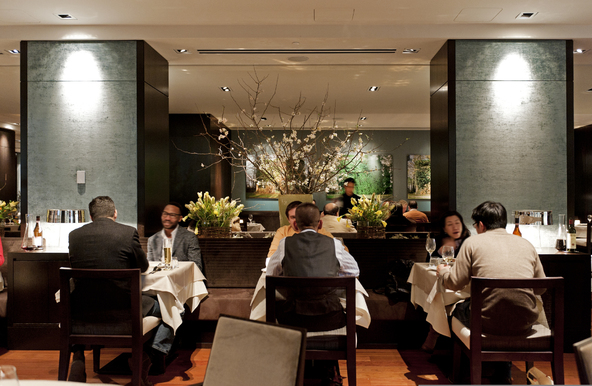 Two
years ago celebrated chef Michael White (below) opened a
deluxe restaurant named Ai Fiori ("among the flowers")
that veered from the committed Italian style of his
other successes, Marea and Osteria Morini. Ai Fiori
was also more posh than previous efforts, and, while
located on the second floor of the Setai Hotel and a
somewhat corporate hotel decor, the style of the
place, with its fine linens, bone china, thin
stemware, flowers, and comfortable seating have made
this a restaurant where one can have a very civilized
and beautifully crafted lunch or dinner.
Two
years ago celebrated chef Michael White (below) opened a
deluxe restaurant named Ai Fiori ("among the flowers")
that veered from the committed Italian style of his
other successes, Marea and Osteria Morini. Ai Fiori
was also more posh than previous efforts, and, while
located on the second floor of the Setai Hotel and a
somewhat corporate hotel decor, the style of the
place, with its fine linens, bone china, thin
stemware, flowers, and comfortable seating have made
this a restaurant where one can have a very civilized
and beautifully crafted lunch or dinner.
White's Altamarea
Group has got his hands full with many
properties, including Al Molo in Hong Kong, so I was
delighted to find him bounding from the kitchen at Ai
Fiori when I had a recent lunch there. I've
known White since he first showed his exceptional
talent at Fiamma, and his ebullience is as fetching as
ever. Chef de cuisine PJ Calapa keeps things in
the air on a day-to-day basis.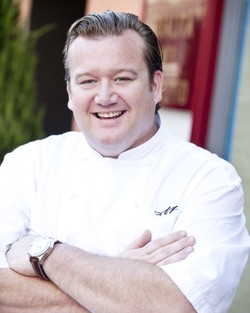
Ai Fiori's menu always has a selection of crudi, as first showcased at Marea, and he does one with fluke, American caviar, and a squirt of Meyer lemon to brighten the piscine flavors. His creamy torchon of foie gras with a lacing of balsamico, crunchy of almonds, and buttery brioche is classic and very good, and his vellutata of lobster with black truffles and bits of chervil is simple in the best sense of the word.
There are of course, all
housemade pastas here, and every one I've tried has
been exemplary, including black
Ligurian trofie
imbued with cuttlefish ink and morsels of more
cuttlefish, scallops, and rare, spiced mollica crabs.
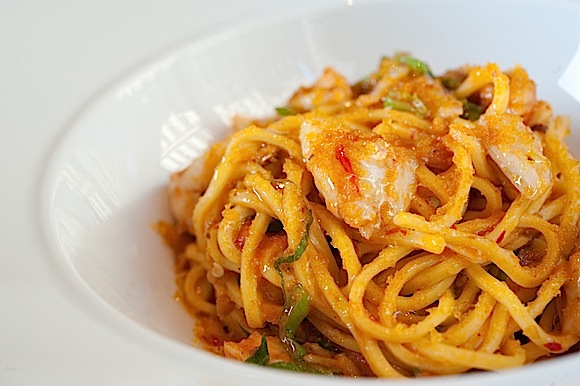 Agnolotti, sheer
and light, are packed with braised veal with a sweet
corn purée and charred corn, veal jus, and basil,
while plump tortelli
come with ricotta and mascarpone, sottocenere
cheese and a fine red wine glaze, a rich dish you
might want as a main course. Something of a signature
White keeps on his menus is the spaghetti with blue
crab, lemon, bottarga,
and chilies (left),
a dish that seems a clash of flavors but is in fact an
impeccably wrought whole on contrasts.
Agnolotti, sheer
and light, are packed with braised veal with a sweet
corn purée and charred corn, veal jus, and basil,
while plump tortelli
come with ricotta and mascarpone, sottocenere
cheese and a fine red wine glaze, a rich dish you
might want as a main course. Something of a signature
White keeps on his menus is the spaghetti with blue
crab, lemon, bottarga,
and chilies (left),
a dish that seems a clash of flavors but is in fact an
impeccably wrought whole on contrasts.
If you feel like seafood as
an entree, any of the day's fish will make you realize
that few chefs in NYC do seafood this well, as with an
olive- oil poached wild striped bass with artichokes barigoule, blue
crab, sea urchin, and lemon. 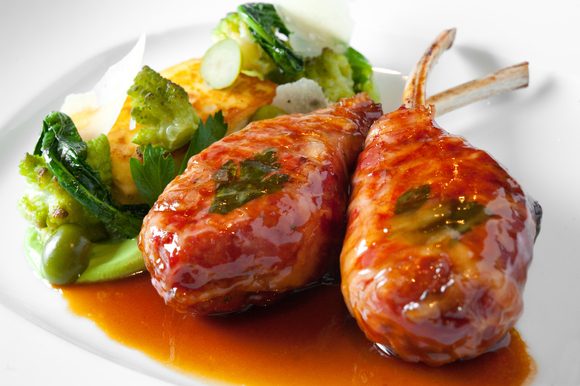 His sea
scallops are always the finest in the market, served
with , fennel, leeks, trout roe, sea and a shellfish
sabayon of real depth. Somehow such strong
flavors only serve to enhance, not cover up, the
delicate sweetness of the scallops.
His sea
scallops are always the finest in the market, served
with , fennel, leeks, trout roe, sea and a shellfish
sabayon of real depth. Somehow such strong
flavors only serve to enhance, not cover up, the
delicate sweetness of the scallops.
At lunch the meat entrees include a roast chicken with cipollini onions, piquillo peppers, fregola, caramelized onion jus; lamb wrapped in caul fat, with, ratatouille, and a tomato confit (right); a strip loin of beef with endive, potato terrine, “cacio e pepe”, and classic bordelaise; and a hamburger with bacon marmalade, American cheese, pickles and pommes dauphines.
For dessert the Ligurian olive oil cake has plenty of fans, and I particularly love chef Alina Martell's crostata of chocolate with spiced pear and pistachio, pear and pear sorbetto.
The winelist has breadth and depth though there are few bargains here and too few bottles under $50. Prices for food have gone up considerably, too, since Ai Fiori opened, but you'll still dine more lavishly here than at most of the deluxe French restaurants around NYC. And you will dine very well indeed.
Ai Fiori is open for
breakfast daily, brunch Sat. & Sun., Lunch
Mon.-Fri., and dinner nightly. Lunch, $42 for two
courses; Dinner menu for 4 courses $92; tasting menu
$130.
❖❖❖
NOTES FROM THE WINE CELLAR
PIONEER NAPA VALLEY WINE MAKER IS BACK
by Mort Hochstein
 Bernard
Portet is back.
Bernard
Portet is back.
In 2010, Portet (left), one of the
pioneers of Napa Valley viticulture, wrote finis
to more than three decades of winemaking, stopped to
watch the flowers bloom for a few short months, then ,
before those flowers had a chance to fade away, jumped
back into the California
vineyards he knew so well for so long.
In 1972, Portet and John Goelet, both from
families that had
been part of the French wine industry for many
generations, went
overseas to found Clos
du Val, which became one of California’s flagship
wineries. Just four years
later, Clos du Val made headlines when it and a
handful of upstart
Napa wineries embarrassed the greats growths of Bordeaux
in a historic blind tasting, which became known as The
Judgment of Paris. Portet’s first vintage, entered in
that wine competition without his
knowledge, finished eighth in the tasting, whose results astonished and
embarrassed the French judges. Ten years
later, in a rematch, the French were again upended
when Clos
Du Val finished first. For the next three decades Clos
du Val made its mark early and continued to win honors under
Portet’s leadership.
After his
brief retirement,
Portet and
Don
Chase, a veteran Napa wine executive created
Heritance, which, Portet observes,
“is a winery without walls.” The
partners source their grapes from the vineyards Portet
knew for
so many years and
produce their
wine at a custom crush facility. The
venture, with Portet’s name on it, has taken off
rapidly and Heritance Cabernet, Pinot Noir and
Sauvignon Blanc are now
available in New York,
Illinois, Massachusetts and, of course,
California. Portet
says he continues to observe the dictates he learned as
an adolescent in Bordeaux, aiming for
“balance and
complexity and, always, a long finish. The days of overpowering reds
from Napa are no longer,” he observes. “The wines I make
today are closer to those of my French roots, balanced
between fruit, earth and acidity, and assembled with
an eye toward the foods they will enhance."
“I
was born and raised in the vineyard and the wine
business,” he recalled recently. “My father,
André, 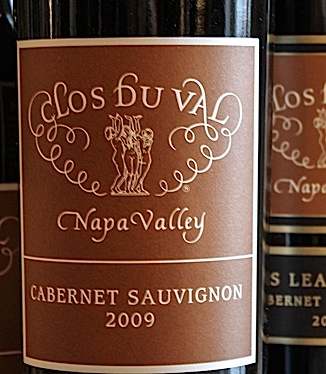 was estate
manager for Château Lafite and from an early
age, I walked
the fields with
him, studying how grapes, soil and weather conditions come together and how those
grapes can be assembled into great wine.” After
studying agronomy,
viticulture and enology in Toulouse and Montpelier, Portet
joined John
Goelet, another member
of a distinguished Bordeaux wine family, and embarked
on a mission to find the
ideal vineyard
”where we
could grow great grapes and make a quality wine.”
Portet toured for two years, visiting and studying
viticulture in
South Africa, Australia, and South America, eventually
seizing on the Napa valley as the ideal place to
realize his goals. “I
was impressed,” he noted recently, “with the intense
and powerful wines being made at the early stage and could see
Napa’s potential
for great Cabernet Sauvignon.”
was estate
manager for Château Lafite and from an early
age, I walked
the fields with
him, studying how grapes, soil and weather conditions come together and how those
grapes can be assembled into great wine.” After
studying agronomy,
viticulture and enology in Toulouse and Montpelier, Portet
joined John
Goelet, another member
of a distinguished Bordeaux wine family, and embarked
on a mission to find the
ideal vineyard
”where we
could grow great grapes and make a quality wine.”
Portet toured for two years, visiting and studying
viticulture in
South Africa, Australia, and South America, eventually
seizing on the Napa valley as the ideal place to
realize his goals. “I
was impressed,” he noted recently, “with the intense
and powerful wines being made at the early stage and could see
Napa’s potential
for great Cabernet Sauvignon.”
Convinced
that better grapes came from the hillsides, he established Clos du Val
in the then relatively unpopulated Stags’ Leap
appellation. "I was newly married, and I told my wife I
expected to be in California for only a short time,
but John
Goelet wanted me
to stay to buy equipment and oversee the operation. I
had to make decisions
on, say, the diameter for a pump. I’d never
chosen a pump or purchased hoses
previously. That
short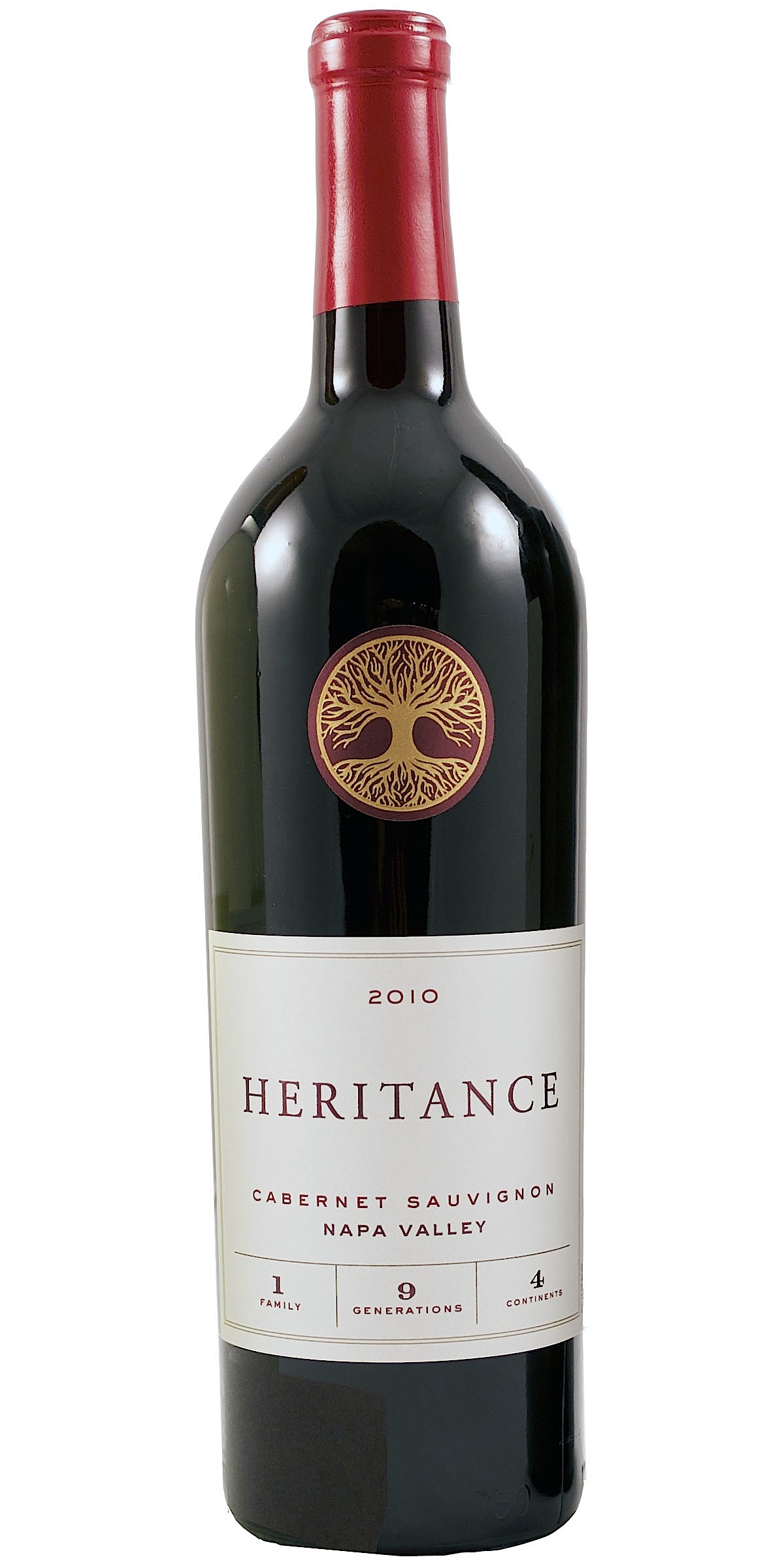 time
turned into 40 years.”
time
turned into 40 years.”
In
October of ’72, rains came just after he’d harvested
80 percent of his first
grape crop, and
he never brought in the remaining 20 percent. “They
were rotten and I would not touch them,” he
recalled. That
problematic vintage, however, was the one that put
Clos du Val on the map and, he observed, “the rest is
history.” Napa
was just beginning its long ascendance in the
seventies and Portet was one of the vintners who
helped Napa win its high esteem in the world of wine.
Today,
in his winery without
walls or fields, he has a freer hand and is able to
change his blends as the situation arises: "I no
longer worry about pumps or presses that can break,
and while I work closely with the growers, I am not
responsible for the vineyards. Without those
responsibilities I can be more creative, more flexible, and
I can experiment with small lots. And change my
blends as I see fit.”
As a treat for a group of
writers assembled to sample the Heritance
line, Portet brought
out a
treasured bottle of that first ’72 Clos du Val. It still
showed good
fruit, soft tannins and hints of spice. I can only
imagine how it was when those French judges ranked that unknown
wine over
the noble Bordeaux in ’76 and again in ’86.
But we there for the Heritance wines and the
Judgment of New York in 2012 is that they show the
balance and elegance
associated
with wines made by Portet. I’d
always found Clos du Val a bit austere, in the mode of
top line Bordeaux, but the Heritance wines are indisputably
much more approachable at an early stage and they
linger long on the palate, a key characteristic of a
Portet wine. I particularly enjoyed his 2010Sauvignon
Blanc, enhanced by Semillon, but he had to change the
blend the next year. In 2011, not happy with the Semillion
crop, he
went into his flexible mode, remembering that some French
winemakers used Roussanne to bolster their Sauvignon.
He was lucky enough to
find good Roussanne grapes in Carneros, so he altered
his blend to make a wine that is similar but a bit
lighter than the 2010.
Since 2003, while still allied with Clos Du
Val, Portet has also been
a commuter to Argentina, where he produces a Malbec
under the Nandu label. Looking to the future, he’s
thinking about trying a Rhone blend and he has other
projects in mind.
With retirement behind him, Portet is doing
what he does best, finding the right grapes and
assembling them into good wine. “I am
enjoying my Heritance adventures, “ he laughs.” My
wife says I should have been doing this ten years
ago.”
❖❖❖
 THEY EVEN
OFFERED TO LET HER TO BRING
THEY EVEN
OFFERED TO LET HER TO BRING
HER OWN
SODA TO THE STORE NEXT TIME
In Kansas, a Family Dollar store employee put 20
twenty laxative tablets in a soda he placed in an
employee fridge, but somehow it was served to a woman
customer, who became violently ill and had to be
hospitalized. When she complained, Family Dollar
offered her a $200 gift card as compensation. Instead,
the women is seeking six figures in damages.
Or
as the late Jim Morrison once put it, "I
believe in a long, prolonged,
derangement of the senses in order to obtain the
unknown."
After eating Chicago chef Grant Achatz's food, NYC chef Jean-Georges Vongerichten
asked him, "I want to know what you're smoking." Achatz (right) said,
"Chef, I'm smoking dreams, man. I'm smoking dreams."
Any of John Mariani's
books below may be ordered from amazon.com.
 |
My latest book, which just won the prize for best book from International Gourmand, written with Jim Heimann and Steven Heller, Menu Design in America, 1850-1985 (Taschen Books), has just appeared, with nearly 1,000 beautiful, historic, hilarious, sometimes shocking menus dating back to before the Civil War and going through the Gilded Age, the Jazz Age, the Depression, the nightclub era of the 1930s and 1940s, the Space Age era, and the age when menus were a form of advertising in innovative explosions of color and modern design. The book is a chronicle of changing tastes and mores and says as much about America as about its food and drink.
“Luxuriating vicariously in the pleasures of this book. . . you can’t help but become hungry. . .for the food of course, but also for something more: the bygone days of our country’s splendidly rich and complex past. Epicureans of both good food and artful design will do well to make it their coffee table’s main course.”—Chip Kidd, Wall Street Journal.
“[The menus] reflect the amazing craftsmanship that many restaurants applied to their bills of fare, and suggest that today’s restaurateurs could learn a lot from their predecessors.”—Rebecca Marx, The Village Voice. |
"Eating Italian will never be the same after reading John Mariani's entertaining and savory gastronomical history of the cuisine of Italy and how it won over appetites worldwide. . . . This book is such a tasteful narrative that it will literally make you hungry for Italian food and arouse your appetite for gastronomical history."--Don Oldenburg, USA Today. "Italian
restaurants--some good, some glitzy--far
outnumber their French rivals. Many of
these establishments are zestfully described
in How Italian Food Conquered the World, an
entertaining and fact-filled chronicle by
food-and-wine correspondent John F.
Mariani."--Aram Bakshian Jr., Wall Street
Journal.
"Equal parts
history, sociology, gastronomy, and just
plain fun, How Italian Food Conquered the
World tells the captivating and delicious
story of the (let's face it) everybody's
favorite cuisine with clarity, verve and
more than one surprise."--Colman Andrews,
editorial director of The Daily
Meal.com. "A fantastic and fascinating
read, covering everything from the influence
of Venice's spice trade to the impact of
Italian immigrants in America and the
evolution of alta cucina. This book will
serve as a terrific resource to anyone
interested in the real story of Italian
food."--Mary Ann Esposito, host of PBS-TV's
Ciao
Italia. "John Mariani has written the
definitive history of how Italians won their
way into our hearts, minds, and
stomachs. It's a story of pleasure over
pomp and taste over technique."--Danny Meyer,
owner of NYC restaurants Union Square Cafe,
Gotham Bar & Grill, The Modern, and
Maialino.
|
 |
 |
 |
 |
 |
 |
 |
 |
 Everett Potter's Travel Report:
Everett Potter's Travel Report: 
 Eating Las Vegas
is the new on-line site for Virtual Gourmet
contributor John A. Curtas., who since 1995
has been commenting on the Las Vegas food
scene and reviewing restaurants for Nevada
Public Radio. He is also the
restaurant critic for KLAS TV, Channel 8 in
Las Vegas, and his past reviews can be
accessed at KNPR.org.
Click on the logo below to go directly to
his site.
Eating Las Vegas
is the new on-line site for Virtual Gourmet
contributor John A. Curtas., who since 1995
has been commenting on the Las Vegas food
scene and reviewing restaurants for Nevada
Public Radio. He is also the
restaurant critic for KLAS TV, Channel 8 in
Las Vegas, and his past reviews can be
accessed at KNPR.org.
Click on the logo below to go directly to
his site.

Tennis Resorts Online: A Critical Guide to the World's Best Tennis Resorts and Tennis Camps, published by ROGER COX, who has spent more than two decades writing about tennis travel, including a 17-year stretch for Tennis magazine. He has also written for Arthur Frommer's Budget Travel, New York Magazine, Travel & Leisure, Esquire, Money, USTA Magazine, Men's Journal, and The Robb Report. He has authored two books-The World's Best Tennis Vacations (Stephen Greene Press/Viking Penguin, 1990) and The Best Places to Stay in the Rockies (Houghton Mifflin, 1992 & 1994), and the Melbourne (Australia) chapter to the Wall Street Journal Business Guide to Cities of the Pacific Rim (Fodor's Travel Guides, 1991).


MARIANI'S VIRTUAL GOURMET
NEWSLETTER is published weekly. Editor/Publisher: John
Mariani.
Contributing Writers: Christopher Mariani, Robert Mariani,
John A. Curtas, Edward Brivio, Mort Hochstein,
Suzanne Wright, and Brian Freedman. Contributing
Photographers: Galina Stepanoff-Dargery,
Bobby Pirillo. Technical Advisor: Gerry McLoughlin.
© copyright John Mariani 2012
